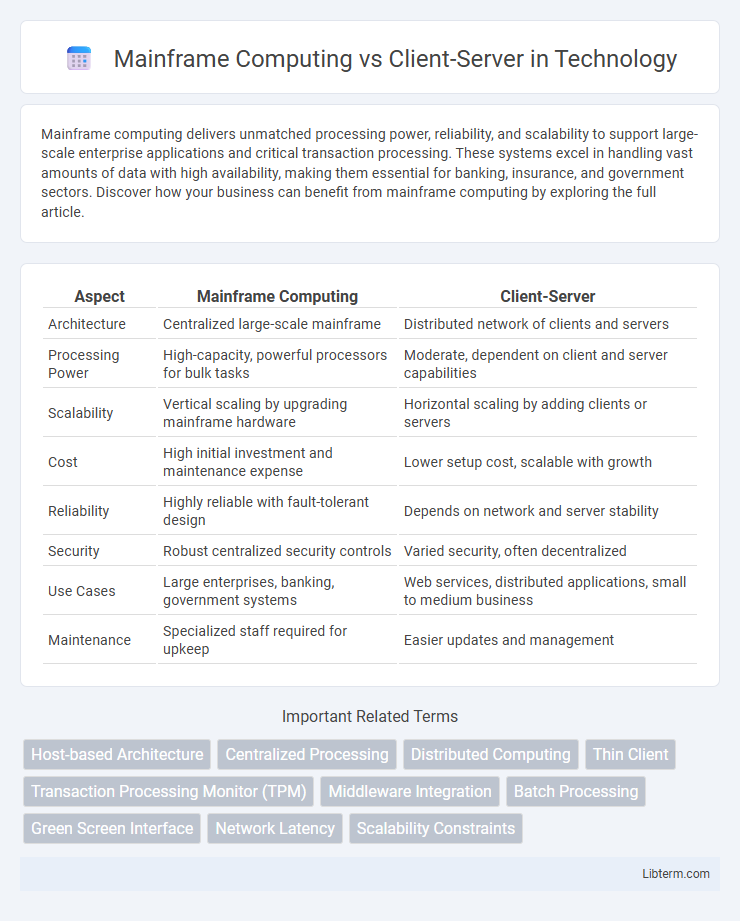Mainframe computing delivers unmatched processing power, reliability, and scalability to support large-scale enterprise applications and critical transaction processing. These systems excel in handling vast amounts of data with high availability, making them essential for banking, insurance, and government sectors. Discover how your business can benefit from mainframe computing by exploring the full article.
Table of Comparison
| Aspect | Mainframe Computing | Client-Server |
|---|---|---|
| Architecture | Centralized large-scale mainframe | Distributed network of clients and servers |
| Processing Power | High-capacity, powerful processors for bulk tasks | Moderate, dependent on client and server capabilities |
| Scalability | Vertical scaling by upgrading mainframe hardware | Horizontal scaling by adding clients or servers |
| Cost | High initial investment and maintenance expense | Lower setup cost, scalable with growth |
| Reliability | Highly reliable with fault-tolerant design | Depends on network and server stability |
| Security | Robust centralized security controls | Varied security, often decentralized |
| Use Cases | Large enterprises, banking, government systems | Web services, distributed applications, small to medium business |
| Maintenance | Specialized staff required for upkeep | Easier updates and management |
Introduction to Mainframe Computing and Client-Server Models
Mainframe computing centers around powerful, centralized computers designed for large-scale transaction processing, high-volume data handling, and enterprise resource management, ensuring reliability and security for mission-critical applications. Client-server models distribute processing across multiple networked devices, with clients requesting services and servers delivering resources, enhancing scalability and flexibility in business environments. Understanding the architectural differences reveals mainframes excel in centralized control and robustness, while client-server systems prioritize modularity and ease of maintenance.
Historical Evolution of Mainframe and Client-Server Architectures
Mainframe computing emerged in the 1950s as a centralized processing model supporting large-scale enterprise operations with centralized data storage and batch processing. Client-server architecture developed in the 1980s with the rise of personal computers, distributing computing tasks between client machines and centralized servers to improve scalability and user interactivity. The evolution reflects a shift from monolithic, centralized mainframes to distributed, networked client-server systems optimized for diverse application demands and real-time processing.
Core Architecture: Mainframe vs Client-Server
Mainframe computing centers on a powerful centralized system handling vast amounts of data processing with multiple terminals connected to a single mainframe server, ensuring high reliability and scalability. Client-server architecture distributes processing tasks between multiple client machines and servers, allowing for more flexible resource allocation and easier maintenance across networks. The core distinction lies in mainframes' centralized control and processing capacity versus the decentralized, interactive approach of client-server models.
Performance and Scalability Comparison
Mainframe computing delivers exceptional performance by handling massive transaction volumes with high throughput and low latency, optimized for large-scale, mission-critical applications. Client-server architectures offer flexible scalability by distributing workloads across multiple servers, supporting dynamic resource allocation and easier horizontal expansion. Mainframes excel in vertical scalability with robust processing power, whereas client-server models provide better adaptability for scaling out in cloud and distributed environments.
Security Features in Mainframe vs Client-Server Systems
Mainframe computing offers robust security features such as centralized access control, extensive auditing capabilities, and hardware-based encryption, making it highly resistant to unauthorized access and cyber threats. In contrast, client-server systems rely on distributed security measures often vulnerable to endpoint attacks and inconsistent policy enforcement. Mainframes provide superior data integrity and secure multi-user environments critical for industries requiring stringent regulatory compliance.
Cost Analysis: Implementation and Maintenance
Mainframe computing typically involves higher initial implementation costs due to expensive hardware and specialized personnel but offers lower maintenance overhead through centralized management. Client-server architectures incur moderate implementation expenses, with diverse hardware and software components, but maintenance costs can escalate as the number of distributed servers and clients grows. Total cost of ownership analysis should consider scalability, hardware lifecycle, software licensing, and downtime impact for both models to determine long-term cost efficiency.
Use Cases and Industry Applications
Mainframe computing is predominantly used in industries requiring high-volume transaction processing, such as banking, insurance, and government sectors, due to its scalability, security, and reliability. Client-server architecture is favored in applications demanding distributed computing and user interface flexibility, common in retail, healthcare, and small to medium enterprises. Both models address specific enterprise needs, with mainframes excelling in centralized data processing and client-server systems supporting interactive, multi-tier applications.
Flexibility and Adaptability in Modern IT Environments
Mainframe computing offers exceptional stability and centralized control, enabling robust processing of large-scale transactions but can be less flexible in adapting to rapidly changing IT requirements. Client-server architectures provide greater flexibility and adaptability by allowing distributed computing resources, facilitating easier integration with cloud services and modern application development. Modern IT environments often leverage client-server models for scalable, agile solutions while using mainframes for critical, high-volume processing tasks.
Future Trends in Mainframe and Client-Server Computing
Mainframe computing is evolving with increased integration of AI-driven analytics, enhanced cybersecurity measures, and support for hybrid cloud environments, ensuring its relevance in large-scale enterprise operations. Client-server computing trends emphasize microservices architecture, edge computing, and containerization to improve scalability and flexibility for distributed applications. Both paradigms are converging towards hybrid models that leverage mainframe robustness and client-server agility to address future enterprise IT demands.
Choosing the Right Model: Factors to Consider
Choosing between mainframe computing and client-server architecture depends on factors such as scalability, workload size, and security requirements. Mainframes excel in handling massive transaction volumes with high reliability and centralized control, making them ideal for large enterprises and critical applications. Client-server models offer greater flexibility, easier maintenance, and cost efficiency for distributed environments and smaller-scale operations.
Mainframe Computing Infographic

 libterm.com
libterm.com